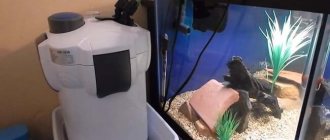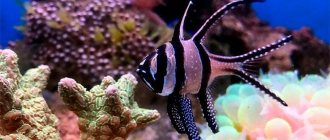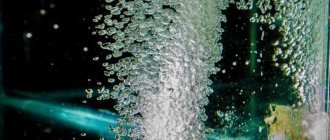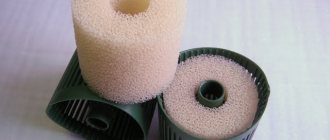Creating an extraordinary and well-functioning aquarium with colorful fish and lush plants is no easy task. Most often, beginner aquarists encounter difficulties when selecting equipment: in addition to lighting and filtration devices, they will need an aquarium pump - one of the most necessary devices in the aquarium hobby. Thanks to the operation of this device, the water is saturated with oxygen, and proper living conditions are created for representatives of flora and fauna. In order for the device to serve for a long time and work efficiently, you should know how to choose a pump for an aquarium.
What is a pump for?
The world of aquarium keeping is vast and diverse, so beginners in this field are often confused when they hear how much it takes to create a home aquarium. For example, many novice aquarists do not know what an aquarium pump or water pump is - and yet, this is one of the most useful designs.
It is no secret for experienced water enthusiasts that in order to reproduce fish at home, it is necessary to supply oxygen to the reservoir. If there is no aeration in the aquarium, or it is organized incorrectly, then this negatively affects the well-being and health of small pets - they get sick and die. This also leads to turbidity in the aquatic environment, the formation of an unpleasant odor and siltation of the soil. To prevent such incidents from happening, aquarists use a pump - this is what a pump is for.
Device maintenance
The aquarium must be maintained systematically, including the equipment used. A simple pump consists of a plastic cup containing a filter sponge, liquid tubes and a motor. Before cleaning any type of device, it must be turned off.
Aquarists recommend carrying out a complete cleaning of the external device no more than once every 6 months and in emergency cases when the liquid pressure sharply decreases. Cleaning steps:
The internal pump is serviced as needed. The plastic body is cleaned of plaque with brushes, and the filter material is washed with aquarium water.
To keep the sponges of the device clean longer, turn off the device while feeding the fish, then food will not get on the filter. As soon as the animals eat, the device turns on again.
Types of pumps
The stores offer various models from different manufacturers - they all differ in appearance and in the way they are placed. Pumps are:
- External.
- Internal.
- Universal.
An external pump in an aquarium is installed from the outside, while internal models are immersed directly in the water. Universal designs are good because they can be fixed on both sides of the tank without any problems.
In addition, water pumps can be divided into two more types:
- For a pond with regular water.
- For aquariums with salty liquid.
The difference is that freshwater models have a metal axle. Such models are not used in containers with salt water, since the axle will quickly become covered with rust, so ceramics are used for sea water bodies.
Design features, principle of operation
There are several characteristic features that different models have and which are taken into account when choosing.
- Power adjustment . Some pumps have only one constant mode, but it is more convenient if the flow force can be adjusted at your own discretion.
- Possibility of complete immersion in water . Typically, universal pumps have this option. They are made from materials that can easily withstand exposure to water, do not deteriorate, and do not become unusable.
- Mounting method . The suction cup is considered the most versatile and simple option. But it is important to ensure that it is of high quality and holds the pump on the wall of the aquarium, preventing it from slipping.
- Fence grate . A very useful design element that increases its safety. Acts as a protector for fish and other inhabitants of the aquarium, so that the running pump does not harm them, and so that plants are not sucked into the filter.
Powerful pumps, which are installed in aquariums for large aquatic inhabitants, can additionally have aesthetic functions. For example, pumps work in several directions and draw a pattern inside the water using air bubbles.
How to choose the right one
The stores offer a wide range of water pumps for the tank, so many beginners get confused and don’t know which pump to choose for the aquarium. There are several important factors to consider before purchasing a specific model.
Purpose of application
When choosing a pump, you should first decide for what purpose the design is being purchased:
- Filtration will require the use of a sponge if one is not provided by the manufacturer.
- Aeration requires a hose placed above the surface of the liquid.
- To create water flows, you need a flow pump that mixes the water layers.
- If a pump is purchased to fill a tank, you need to take into account the level of liquid rise and the drain hose.
Reservoir volume
The power of the device is selected based on the volume of the artificial reservoir. In small tanks, pumps with a capacity of up to 380 l/h are used, in medium-sized tanks - up to 600 l/h. If a giant tank of more than 500 liters is installed at home, then you will need a device with a capacity of 5000-8000 l/h. In order not to make a mistake, you can use special tables for calculating pump power.
Device selection
Today, manufacturers produce aquarium pumps and pumps of various models. To choose the right device correctly, you need to consider various factors . Particular attention should be paid to the technical characteristics of the equipment:
- Device type. Based on the conditions of use, they are external, submersible and universal. The first ones are fixed outside the aquarium, the second ones are under water and are more often used by aquarists. Universal devices can be installed on both sides.
- Performance. It should be at least 3 times and maximum 5 times the volume of the container. The throughput of the device is indicated in the manufacturer's technical documentation.
- Power. It is more economical to choose a water pump for an aquarium with a low power, since it works continuously, but it should be enough to make the aquatic environment in the tank comfortable.
- Material. All types of devices have a plastic case. The only difference is the raw material from which the engine axle is made. In freshwater aquariums the axis is metal, while in saltwater tanks it is ceramic.
- Noisy. Unlike a compressor, pumps are less noisy. The level of this indicator is indicated in the device passport.
You need to pay attention to device manufacturers. You should not buy cheap devices from unknown brands. As a rule, they are low-power, noisy, fail quite quickly and do not have a warranty period.
Popular models
Models from different manufacturers have their own advantages and disadvantages; each model also differs from the other in appearance, equipment, availability of adjustments, price and quality. In aquarium circles, pumps from the following manufacturers have good reviews:
- Eheim - devices belong to a universal group according to the installation method. Perfect for different types of aquariums. The power of these pumps can also be adjusted.
- Resun - affordable models for small and medium capacity tanks. The lowest productivity is 200 l/h.
- Hailea - devices of this brand are equipped with suction cups and a power regulator, and are available for containers of different sizes.
- Aquael – the smallest capacity of these devices is 350 l/h, suitable for small and medium-sized containers.
- Aquarium system - high-quality devices equipped with overheating protection and flow power regulator.
- Tunze are proven and reliable pumps with different power ratings. They are good because they do not make noise during operation.
If store-bought pumps do not suit the aquarist, then if you have experience and knowledge, you can try to make a water pump yourself. If this is your first experience assembling equipment at home, then it is better to take risks - an incorrectly assembled structure can lead to dire consequences.
Equipment functionality
Pumps can perform various functions - create a flow, purify water, work to replace water.
The flow pump is a device that was originally created for salt water aquariums, but has found wide application in fresh water. With its help, layers of liquid are mixed and a flow effect is created, which some animals like so much. The advantage of the device is a wide and diffuse flow of expelled water and silent operation.
An aquarium filter pump cleans the liquid from mechanical impurities by driving it through a special sponge. Water is captured from the tank, passed through the sponge, purified there and returned to the aquarium. In modernized models, coal is added to the bowl of the device for a chemical reaction. This device requires special care; it and the aquarium must be cleaned regularly.
A pump for pumping out liquid is used for changing water in aquariums with a large volume. It is enough to select a hose that is attached at one end to the device and at the other to the drainage point in order to quickly drain the liquid and replace it with a new one.
Installation and care
The method of installing a pump in an aquarium depends on the type of device: internal models are immersed headlong in water. External structures should be located outside, away from outlets. Caring for the pump is very simple and consists of periodically cleaning the device. If this is an internal model, then before cleaning the device is turned off and removed from the water, then washed. Filter media must be replaced every 4-6 months, but these recommendations may change depending on the structure of the device.
An aquarium pump is a reliable and multifunctional device that can replace two devices at once: an aerator and a filter. In addition, a pump creates a current, which is a vital necessity for certain types of fish, and ensures cleanliness and uniform temperature in different layers of the water column.
What parameters to choose a pump for an aquarium
There are criteria by which this type of device is selected.
- Pump installation type. . There are pumps for external and internal installation. Many people prefer pumps that are mounted outside, explaining that in this case the appearance of the aquarium is not overshadowed in any way and its harmony is not disturbed. There are also universal pumps that can be installed both outside and inside.
- Material of manufacture . Affects the ability to operate the pump in salt or fresh water. For fresh, more materials are suitable, including stainless steel. For salted ones, you need to choose more carefully, since sea salts have a destructive effect even on steel alloys. In pumps that are designed for such an environment, metal parts are replaced with ceramic ones.
- Power . To determine the optimum, take into account the size and volume of the aquarium. The smaller it is, the less powerful the pump is required to cope with the volume of water. If we are talking about large-sized aquariums that are installed in large houses and non-residential premises, then the pump should be more powerful.
- Productivity . In combination with power, it determines the pump’s ability to cope with volume, therefore it is measured in liters per hour. For household, industrial, and exhibition aquariums, the norm is considered to be a productivity of about 3–5 volumes per hour. If the pump fills the aquarium with water, then additionally take into account the height to which the water can rise when pumping. This parameter depends on the size of the pump itself and also plays a role in creating artificial waterfalls and streams.
- Noise level . Mechanical work always creates a sound load. The larger the pump, the more noise it makes. Although many manufacturers are optimizing technology so that the pump makes less noise. Some models are even chosen for an aquarium that is installed in a bedroom or living room - as a result, they do not interfere with everyday activities and relaxation.
Each manufacturer tries to introduce certain features into the design of the pump in order to make it more efficient, aesthetically attractive, and convenient to use.
What is the pump for?
Its main task is to ensure the normal functioning of the aquarium: pumping and mixing water, supplying oxygen. It is this that creates the pressure necessary for the operation of the external filter. If necessary, it helps to create a current in the water, promotes the operation of the aerator, and slows down the process of contamination of the tank.
There are several varieties of this device:
- internal type;
- external (or external);
- universal model.
Purpose and principle of operation
Animals in an artificial reservoir need a sufficient amount of oxygen. Poor aeration causes the water to quickly become cloudy. This has a detrimental effect on the health and vital activity of the living inhabitants of the container. And the tank begins to look unsightly. Gradually the aquarium turns into a small swamp.
Pumps pumping water are necessary in order to avoid all these unpleasant consequences. They perform the following functions:
- Keeping the tank clean.
- Saturation of aquarium water with oxygen.
- Creating circulation.
Air supply for aquarium animals and plants must be provided constantly, especially at night. This is due to the fact that during the daytime oxygen is released under the influence of light, and at night the process stops. As a result, the reservoir becomes oversaturated with carbon dioxide. Thanks to the pump, oxygen constantly enters the container. You can purchase a filter pump in the form of a foam rubber sponge. In this case, the speed of water purification occurs faster.
A pump should also be purchased in the following cases:
- Reservoir overpopulation.
- Non-standard container shape. The pump must be used in a tank that is too narrow or deep.
- There are no living plants in the artificial pond. The device is also needed in case of too much vegetation.
- If water biofiltration is impaired.
- The container with fish is closed with a lid without holes.
An aquarium pump prevents the appearance of greasy deposits in the upper layers of water. The device mixes the liquid, equalizing the temperature in the tank. The pump is also a decorative element. The resulting bubbles fall in a cascade, simulating a fountain or waterfall.
Types of compressors
There are two types of compressors for aquariums: piston and membrane.
Piston type - the medium is supplied into the nozzle cavity for spraying using a piston.
Membrane - supply oxygen to the atomizing element using a membrane.
Diaphragm air pumps
In a membrane-type compressor, air is supplied to the atomization elements using a rubber membrane. This type is characterized by low noise level and low power (economical). They are used in small containers (up to 150 liters). They have high quality and efficiency indicators.
How to make a membrane pump for an aquarium with your own hands
Piston modifications
Piston compressors are wear-resistant and have a wide range of power options. Piston compressors are used in aquariums up to 100 liters. The disadvantage of these compressors is their relatively high cost compared to membrane compressors, as well as a high noise level.











